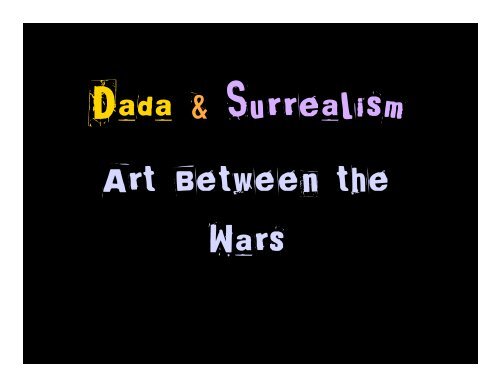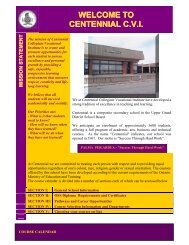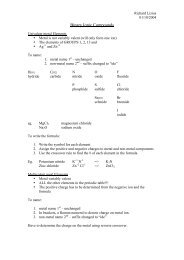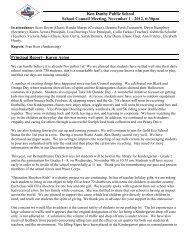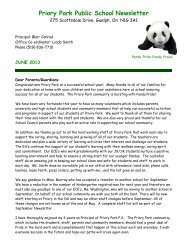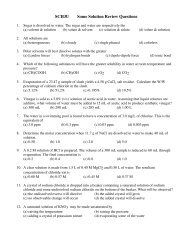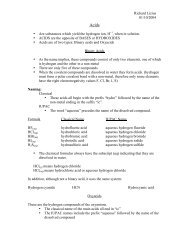Dada & Surrealism
Dada & Surrealism
Dada & Surrealism
You also want an ePaper? Increase the reach of your titles
YUMPU automatically turns print PDFs into web optimized ePapers that Google loves.
<strong>Dada</strong> & <strong>Surrealism</strong><br />
Art Between the<br />
Wars
DADA<br />
LOCALE: Founded in Zurich<br />
PERIOD: 1916-1922<br />
ARTISTS: Jean Arp<br />
Kurt Schwitters<br />
Marcel Duchamp<br />
FEATURES:<br />
• Seems nonsensical<br />
• Protested the madness of war<br />
• Aim: to waken the imagination<br />
• Founded in Zurich in 1916 by a group<br />
of refugees from World War 1, the<br />
<strong>Dada</strong> group got its name from a<br />
nonsense word<br />
• Had a brief lifespan of 7 years<br />
• <strong>Dada</strong> often seemed nonsensical but<br />
its aim was to protest the war<br />
• In World War 1 (deemed “the war to<br />
end all wars) ten million people were<br />
killed or maimed<br />
• <strong>Dada</strong>ists felt that they could no longer<br />
trust reason or the establishment<br />
• They decided to overthrow all<br />
authority and cultivate absurdity
DADA<br />
• <strong>Dada</strong> became international as it spread from Zurich, to France, Germany<br />
and the United States<br />
• Its main strategy was to denounce and shock<br />
• A typical <strong>Dada</strong> evening consisted of poets reciting nonsense verse<br />
simultaneously in different languages while others barked like dogs.<br />
Orators hurled insults at the audience while absurdly costumed dancers<br />
danced around the stage<br />
“We spoke of <strong>Dada</strong> as a crusade that would win back the promised land of<br />
the creative”<br />
~ Jean Arp, a founder of <strong>Dada</strong>
DADA<br />
Jean Arp<br />
• Arp was a German-French abstract<br />
painter, sculptor, poet and mixed<br />
media artist<br />
• He discovered the principle of random<br />
collage by accident when he tore up a<br />
drawing an threw the pieces on the<br />
floor<br />
• Admiring the haphazard collages, Arp<br />
began to make “chance” collages<br />
• His characteristic work featured<br />
playful, egg-like shapes that suggest<br />
living creatures<br />
Jean Arp. Mountain, Table, Anchors, Navel.<br />
1925. Gouache on cardboard with cut-outs.
DADA<br />
Kurt Schwitters<br />
Kurt Schwitters. Merz 88. Red Stroke.<br />
1920. Cut-and-pasted coloured and printed<br />
papers and crayon on paper.<br />
• German collagist Kurt Schwitters<br />
subverted accepted concepts. When<br />
asked “What is art?” he replied, “What<br />
isn’t?”<br />
• He cruised the streets of Hanover looking<br />
for discarded junk like bus tickets, buttons<br />
and shreds of paper. He then combined<br />
these items into assemblages he called<br />
“merz”<br />
• Arp and Schwitters used these “non art”<br />
materials instead of more traditional<br />
materials in order to “avoid any reminder of<br />
the paintings which seem to us to be<br />
characteristic of a pretentious, selfsatisfied<br />
world”
Marcel Duchamp<br />
• French Artist Marcel Duchamp was<br />
one of the most influential figures in<br />
modern art<br />
Marcel Duchamp. Nude Descending<br />
a Staircase, No.2. 1912. Oil on<br />
Canvas<br />
• Duchamp was involved in the <strong>Dada</strong><br />
and <strong>Surrealism</strong> movements<br />
• Although one of his early works, a<br />
painting entitled “Nude Descending a<br />
Staircase”, received a lot of fame, he<br />
chose to abandon painting at the<br />
height of his celebrity<br />
• For Duchamp, conceiving a work of<br />
art was more important than the<br />
finished work<br />
• In 1913 he invented a new form of art<br />
called “readymades” by mounting a<br />
bicycle wheel on a kitchen stool
DADA Marcel Duchamp<br />
Marcel Duchamp. Fountain.<br />
1917. Found Object.<br />
Marcel Duchamp. Bicycle<br />
Wheel. 1913. Found Object.<br />
• His most famous object, Fountain, was signed<br />
“R. Mutt”. The artist submitted it anonymously<br />
into a New York art show in 1917 where it was<br />
rejected<br />
• The inclusion of a signature questions the role<br />
of the artist (name, fame) as well as the<br />
precious nature of art objects<br />
• Duchamp’s “readymades”<br />
are everyday manufactured<br />
objects converted into works<br />
of art simply by the artist’s<br />
act of choosing them<br />
• The are a gesture of total<br />
rejection and revolt against<br />
traditional notions of “what is<br />
art”<br />
• By reducing the creative act<br />
to simply to one of choice,<br />
the “readymades” discredit<br />
the ‘work of art’, along with<br />
taste, skill and craftsmanship<br />
• The significance of the<br />
“readymades” as art does<br />
not lie in any aesthetic<br />
qualities, but rather in the<br />
aesthetic questions they<br />
force the viewer to<br />
contemplate
<strong>Surrealism</strong><br />
LOCALE: Europe and America<br />
PERIOD: Mid 1920s-1960s<br />
ARTISTS:<br />
Joan Miró<br />
Max<br />
Ernst Marc<br />
Chagall René Magritte Salvador Dalí<br />
Meret Oppenheim<br />
Frida Khalo<br />
FEATURES:<br />
• Experimentation with “automatism”-<br />
a form of creating without conscious<br />
control<br />
• Goes beyond reason<br />
• Bizarre and irrational imagery to<br />
express buried truths unreachable by<br />
logic
<strong>Surrealism</strong><br />
• Two years after the offspring of the <strong>Dada</strong> movement, <strong>Surrealism</strong><br />
was born<br />
• <strong>Surrealism</strong> began as a literary movement, fostered by the poet<br />
André Breton<br />
• It grew out of Freudian dream analysis (the beginnings of<br />
psychology- Sigmund Freud)<br />
• Freud developed theories based on the unconscious mind…<br />
Example: “Freudian Slip”= when we say something aloud by accident that reveals a truth<br />
(of the unconscious mind) rather than the message we meant to say.<br />
<strong>Surrealism</strong> took on two forms:<br />
• Improvised Art- where artists attempted to distance<br />
themselves as much as possible from conscious<br />
control<br />
• Hallucinatory Scenes- realistic techniques used to<br />
depict scenes that defy common sense
<strong>Surrealism</strong><br />
Joan Miro<br />
• Miró consistently tried to banish reason<br />
and lose the unconscious<br />
• Working spontaneously, he moved the<br />
brush over the canvas drawing squiggles<br />
in trance-like state<br />
• He invented unique biomorphic signs for<br />
natural objects like the sun, moon, and<br />
animals<br />
• His forms became progressively<br />
simplified into geometric shapes and<br />
amoeba-like blobs<br />
• His shapes can be described as semiabstract.<br />
They were always playful,<br />
stylized and they alluded to real objects<br />
Miro. Dutch Interior II, c.1920. oil on canvas.<br />
• His work was very colourful and cartoonlike
<strong>Surrealism</strong><br />
Max Ernst<br />
• Both a <strong>Dada</strong>ist and Surrealist, Ernst best<br />
exemplified how the Surrealists employed<br />
ambiguous titles for their work<br />
• His “Two Children are Threatened by a<br />
Nightingale” apparently derived from the<br />
death of his sister and a hallucination he<br />
had as a child<br />
• He claims to have experienced<br />
hallucinations which he adapted into his<br />
art works<br />
• Ernst invented “frottage”, a new method<br />
for generating surprising imagery<br />
Ernst. Two Children Are Threatened by a<br />
Nightingale. 1924. Oil on wood with painted<br />
wood elements and frame.<br />
• He placed a sheet of paper over rough<br />
surfaces like wood and rubbed with a soft<br />
pencil. He then created fantastic,<br />
sometimes monstrous imagery out of the<br />
shapes
<strong>Surrealism</strong><br />
Marc Chagall<br />
• Chagall’s work was inspired by two<br />
sources of imagery: Folklore and Biblical<br />
scenes reflecting his Jewish heritage<br />
• He insisted that he painted actual<br />
memories rather than irrational dreams<br />
Chagall. I and the Village. C.1911. Oil on<br />
canvas.<br />
• Chagall often used symbols in his work:<br />
Cow: life par excellence: milk, meat, leather,<br />
horn, power.<br />
Tree: another life symbol.<br />
Houses (often in paintings of his time in Paris):<br />
feelings for his homeland.<br />
• His works abound with references to his<br />
childhood, yet often neglect some of the<br />
turmoil which he experienced (WW1)<br />
• He communicates happiness and<br />
optimism to those who view his works by<br />
means of highly vivid colors
<strong>Surrealism</strong><br />
René Magritte<br />
• Magritte began his career as a<br />
commercial artist designing wallpaper<br />
and fashion ads<br />
• In his surrealism work he used the<br />
mastery of realism to defy logic<br />
• He placed everyday objects in<br />
incongruous settings<br />
Magritte. The False Mirror. 1928. Oil on Canvas.<br />
Magritte. La Trahison des Images [The<br />
Treachery of Images]. 1928-9. Oil on Canvas.<br />
• His disturbing juxtapositions of familiar<br />
sights in unnatural contexts gave new<br />
meanings to familiar things<br />
• He painted pipe that looks as though it<br />
is a model for a tobacco store<br />
advertisement and wrote below: “Ceci<br />
n'est pas une pipe”, which seems a<br />
contradiction, but is actually true: the<br />
painting is not a pipe, it is an image of<br />
a pipe
<strong>Surrealism</strong> Meets YouTube<br />
Magritte. The False Mirror. 1928. Oil on Canvas.<br />
http://www.youtube.com/watch?v=E7gOz46ZGBM
<strong>Surrealism</strong><br />
Salvidor Dali<br />
• An inventive self-promoter, Dali<br />
became known as Mr. <strong>Surrealism</strong><br />
more through public gimmicks<br />
than art. Example: He gave a press<br />
conference with a boiled lobster on<br />
his head.<br />
• Dali represented his<br />
hallucinations with meticulous<br />
realism but he distorted objects<br />
grotesquely and placed them in<br />
unreal landscapes<br />
Dali. The Persistence of Memory. 1931. Oil on Canvas.<br />
• Although metallic, the watches seems to<br />
be decomposing along with the<br />
unidentifiable “flesh” in the centre of the<br />
painting<br />
• A fly and jewel-like ants swarm over the<br />
rotting clocks<br />
• Dali tried to capture the<br />
hallucinatory clarity of dreams in<br />
this painting<br />
• Time stands still in the<br />
dreamer’s mind, as in Freud’s<br />
timeless unconscious- Here, the<br />
clocks go limp and stop forever
Criticism of <strong>Surrealism</strong><br />
Freudian<br />
Freud initiated the psychoanalytic critique of <strong>Surrealism</strong> with his remark that what<br />
interested him most about the Surrealists was not their focus on the unconscious but<br />
their conscious minds.<br />
In this view, the Surrealists may have been producing great works, but they were<br />
products of the conscious, not the unconscious mind.<br />
Feminist<br />
Feminists have critiqued the Surrealist movement claiming that it is fundamentally a<br />
male movement and a male fellowship, despite the occasional few celebrated woman<br />
Surrealist painters and poets.<br />
They believe that it adopts typical male attitudes toward women, such as worshipping<br />
them symbolically through stereotypes and sexist norms. Women are often<br />
transformed into objects of desire and of mystery.
Women Surrealists<br />
No modern art movement gave women such prominence, albeit problematic,<br />
or elevated the role of women in the creative life of the male artist as did<br />
<strong>Surrealism</strong>.<br />
“The problem with women,” Breton wrote in 1929, “is the most marvellous and disturbing problem<br />
in the world.”<br />
When Breton called together the famous Surrealist meeting on the topic of<br />
sexuality, no women were present.<br />
Women were viewed solely as a projection of male desire and need, a<br />
muse, an innocent child, a castrating temptress or an object of sadistic<br />
gratification.<br />
This made it difficult, and somewhat problematic, for women to join the<br />
Surrealist movement, although a number were active in it.
<strong>Surrealism</strong><br />
Meret Oppenheim<br />
• Oppenheim's fur-lined teacup<br />
is perhaps the single most<br />
notorious Surrealist object<br />
• The work takes advantage of<br />
differences in the varieties of<br />
sensual pleasure: fur may<br />
delight the touch but it repels<br />
the tongue<br />
Oppenheim. Object. 1936, Fur-covered cup, saucer, and spoon.<br />
• Chic, wry, and simultaneously attractive<br />
and disturbing, Object is shrewdly and<br />
quietly aggressive<br />
• A small concave object<br />
covered with fur, Object may<br />
also have a sexual<br />
connotation and political<br />
messages: working in a maledominated<br />
art world, perhaps<br />
Oppenheim was mocking the<br />
prevailing "masculinity" of<br />
sculpture
<strong>Surrealism</strong><br />
Frida Kahlo<br />
• Kahlo met poet André Breton when he<br />
went to Mexico in 1938 where he saw<br />
one of her self portraits<br />
• Kahlo painted almost exclusively<br />
portraits of her self<br />
• She explored the reality of her own<br />
body and her consciousness of it, and<br />
the dualities (opposites) of gendered<br />
and cultural identity<br />
Khalo. The Two Fridas. 1939. Oil on Canvas.<br />
• One Frida being the one Riviera<br />
loved, and the other he no longer<br />
loved. Also coupled with her<br />
traditional Mexican identity vs. her<br />
identity as a modern women<br />
• She was publicly celebrated as a<br />
beautiful women enjoying a privileged<br />
life, but she saw herself differently (she<br />
was almost constantly in pain and left partially<br />
disabled due to a streetcar accident in her teens)<br />
• The two Fridas represent her divorce<br />
from her husband Diego Riviera (a<br />
muralist).


